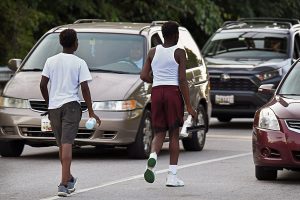
Neighbors
“My car and I just got attacked by squeegee kids after I politely declined their services when pulling into exit six off JFX coming home, so they surrounded my car and lifted up my windshield wipers and sprayed the car down while banging on my glass with their squeegees and cussing me out. I already called the police to inform them…. I can only imagine how I would feel if I had kids or other passengers in my car and how terrifying it would be. These people are menaces and must be stopped firmly or things could end very badly the next time.”
If you are a denizen of social media, perhaps you saw this Bolton Hill Nextdoor.com posting in late April, or others before it from time to time. Maybe you’ve had your car wipers damaged or your open window sprayed. (I have, and it’s annoying.) Each of these posts generates scores of comments, outrage and sympathy for the poster — but also some for the young people who are essentially begging at the northeast corner of Bolton Hill.
Eric Costello, our city council member, bucked this specific complaint to the mayor’s office, calling it “illegal activity.” That triggered a multi-agency email response. Nevertheless, for the most part the guys are still there with their wipers and spray nearly every day, especially during evening rush hours and on weekends.
“When they break the law, we deal with it. Call 911,” said Capt. Fontaine Smallwood, executive officer for the Baltimore Police Department’s central district. But he acknowledged that the cops try to avoid arresting juveniles, even when they misbehave. “Our goal is not to arrest them,” he said. The presence of the young men around North Avenue and Mt. Royal Avenue generates 911 calls every week, he said. “But it’s not illegal to be there. I can’t just go out and arrest everybody.”
For those who don’t drive or who manage to avoid the I-83 exit, here is how it works: youth hover with window-washing stuff on the curb on the east side of the exit ramp, waiting for a red light to stop traffic in all four lanes. Then they swarm around the idled cars, trying to reach as many as possible before the light changes. Sometimes they spill into or across North Avenue. Some are smiling and polite. Others become aggressive, and that sometimes sparks “pack” bad behavior that teenage boys of all races and classes are known to embrace.
Are these simply young dudes having fun with their pals while making a buck? Or are they a symptom of the city and state’s failure to educate and move into the working population large numbers of young people from the city’s grittier low-income neighborhoods? The kids hanging out at North and Mt. Royal don’t live where they are loitering, nor do they attend schools nearby, if at all.
Faith Leach in the mayor’s office calls them “disconnected” — that is, not connected to school or work. She estimated there are at least 18,000 of them in the city, although BPD’s Capt. Smallwood acknowledged that only a small fraction of that population engages with squeegee wipers. He agreed that probably 300 or fewer “squeegee kids” operate around town.
All cities have unemployed or homeless youth and school dropouts, but it is rare to run into squeegeers outside of Baltimore. In New York, then-Mayor Rudy Giuliani used the windshield cleaners as a symbol of disregard for law and order when he took office in 1994. He made them a focus of his bid to improve the quality of life in the city. They went away to avoid jail and have rarely re-emerged. (Giuliani, alas, is still at large.)
Nor are squeegeers a new problem: Baltimore’s city council in 1983 declared unsolicited windshield washing in the streets a crime in response to citizen complaints. (Black council members opposed that new law.) Before she went to prison Mayor Catherine Pugh promised to create new programs to get young people out of intersections; she praised them as entrepreneurs. In 2019 then-mayor Jack Young rolled out a program to eliminate squeegeeing, which his aide described as panhandling.
Last November Mayor Brandon Scott announced a 90-day action plan to provide alternative employment and health, education and housing resources. They lined up 10 jobs at a local hotel, financed by the city. Now he has a bureaucracy working on it.
Scott’s Office of African American Male Engagement, with a staff of eight and a cadre of non-profit partners, sends other adult Black males to the street corners for “a man-to-man exchange” with the squeegeers, most of whom appear to be in their teens. OAAME calls itself “navigators of unique environments” and “advocators for African American males,” 16 to 49. They call their outreach staff “fishers” and the target youth are “the fished.” The program is led by Dr. Andrew Bundley, a former public-school teacher and principal. Bundley has made appearances at the I-83 exit.
Will this elaborate effort to turn begging young people into better citizens make a difference? Some people think we must learn to live with the annoyance, like our fathers and mothers before us.
Kaye Whitehead, who teaches at Loyola University and hosts a WEAA talk show, says “If this was a lacrosse team in the street raising money with buckets for a trip to play in a tournament, no one would have an issue,” she says. “We as a city need to lean in and find ways to support them. The folks who were doing this 40 years ago have grown up, but this generation is running up against the same problems.”
– Bill Hamilton
